THE CONTEXT: The bursting of the Lhonak Lake (glacial lake) and consequent increase in the water levels of river Teesta caused devastating floods in the states of Sikkim, Assam and West Bengal, causing huge devastation. Sudden cloudburst with heavy rainfall in the wake of climate change has been the alleged cause behind this grave disaster in the Teesta River basin.
A study in 2020 listed the South Lhonak lake as among the 10 lakes posing the highest GLOF threats among the 36 glacial lakes in the North Sikkim. The neglect by the government to this warning has landed the people of Teesta Basin into the misery caused by the breaking of the Lhonak lake.
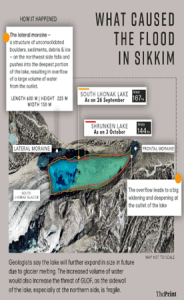
Estimated loss-
- More than 100 people were reported as missing and lives of about 90 people have been lost due to the glacial lake outburst flood.
- The flash floods have swept away 14 bridges and the Chungthang dam of a 1,200-megawatt hydropower project.
- It has forced 2,563 displaced people into 21 relief camps.
From the perspective of UPSC, this article delves into the Glacial Lake Outburst Floods from a broader angle to understand well its causes, implications and the mitigation mechanism necessary.
WHAT IS A GLACIAL LAKE AND HOW IS IT FORMED?
- It is believed that about 10000 years ago, when the glaciers began retreating, they left behind large deposits of ice in the hollows between drumlins.
- Drumlin is an oval or elongated hill formed by the streamlined movement of glacial ice sheets across rock debris, or till.
- Glacial lakes are formed when a glacier erodes the land (through abrasion and glacial plucking) and creates depression and grooves which are then filled by the meltwater from retreating glaciers.
- However, natural dams, formed out of ice and terminal moraines, can also form glacial lakes.
- Moraine refers to the accumulation of rocks and sediments which have been transported or deposited by ice/glacier.
- Lateral moraines are formed along the sides of a glacier.
- Terminal moraine marks the maximum limit of an icesheet or glacier through formation of a linear ridge of glacial material. When such terminal moraines dam the meltwater from glacial retreat, they result into formation of a moraine-dammed glacial lake.
- The terminal moraine exhibits a characteristic ‘kettle and hummock’ topography. Lakes and marshes are likely to occupy the depressions(kettles). Large angular boulders are found in terminal moraines.
- The south Lhonak glacial lake is a classic example of moraine-dammed glacial lake.
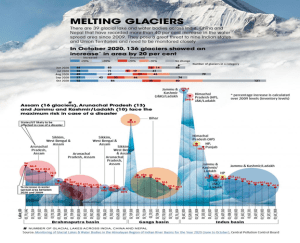
WHAT IS GLACIAL LAKE OUTBURST FLOOD?
- Glacial Lake Outburst Flood (GLOF) is a type of flood that occurs when water dammed by a glacier, or a moraine is released.
- When glaciers melt, the water in these glacial lakes accumulate behind loose, naturally formed ‘glacial/moraine dams’ made of ice, sand, pebbles and ice residue.
- A catastrophic failure of the dam can release the water over periods of minutes to days causing extreme downstream flooding.
- Peak flows as high as 15,000 cubic meters per second have been recorded in such events.
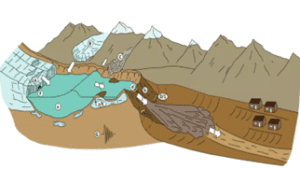
VULNERABILITY OF INDIA TO GLACIAL LAKE OUTBURST FLOODS
- The Himalayan states of India sitting at the foothills of the Hindukush-Himalayan ranges are highly susceptible to disasters like Glacial Lake Outburst Floods (GLOFs).
- There exist over 54,000 glaciers in the Third pole which are retreating at alarming rates due to temperature surges in the wake of Climate Change.
- The average temperature in the region has increased by 0.28°C per decade between 1951 and 2020 which has hastened the glacial lake formation as well as the glacial retreat.
- Scientific assessments and studies indicate the higher vulnerability of the Eastern Himalayas to GFOFs as compared to the Western Himalayan region, with the former facing twice the risks than the latter. This is attributed to the relatively warmer Eastern Himalayas. Further, it is contended that the threats would triple by 2050 with more hotspots emerging farther west.
EXAMPLES OF GLOFs FROM RECENT PAST
Past instances-
o Chamoli floods, Uttarakhand (2021)- caused by melting of Nanda Devi glacier.
o Kedarnath floods, Uttarakhand (2013)- triggered by the Chorabari lake outburst and consequent swelling of river Mandakini.
o Himachal Floods (2005)- caused because of flash flooding by river Parechu.
Impending dangers-
o Warning for Himachal Pradesh- The Gephang Gath Lake is awaiting GLOF similar to the recent Sikkim GLOF.
The lake is growing in its size rapidly. Adding to it, the local topography where it is located and the melting of permafrost have raised the apprehensions of breaking of the banks of this lake soon enough in coming future, which would cause large-scale flash floods in the state.
WHAT ARE THE CAUSES OF GLACIAL LAKE OUTBURST FLOODS?
NATURAL CAUSES:
- Nature of moraine-dammed lakes- The glacial moraines often form temporary glacial lakes and debris cones which are potential sources of associated flash floods.
- As glaciers recede, they deposit large quantities of sediment – composed of an unstable combination of soil and rocks – in the upper regions of the Himalaya. In these circumstances, even a small amount of rainfall can dislodge boulders and debris and leave them to flow downstream.
- Topography- The steep mountains, rock falls, debris flows under the impact of flowing glaciers and landslides are held responsible for breaching the glacial lake boundaries and triggering floods downstream.
- Earthquakes- The Himalayan states of India fall within the seismic zones 4 and 5 which pose high risks to the glacial lakes. The thrusting of Indian plate under the Eurasian plate induces the earthquakes in the region, which trigger rock falls, landslides & breaking of glacial lakes and thus, causing ravaging flash floods.
- Avalanches- Global heating is exacerbating the dangers from increased avalanches in the Himalayan Mountain ranges. The thawing of permafrost in steep mountain slopes can increase the likelihood of rockfalls and large rock avalanches that can enter a lake and trigger GLOFs. E.g. Rishiganga-Dhauliganga deluge in Chamoli (February 2021) due to ice-rock avalanche.
ANTHROPOGENIC CAUSES:
- Climate Change- The incidence and frequency of GLOFs is bound to increase in the wake of climate change. It increases the risks of such floods many-folds due to the following factors:
- Rapidly retreating glaciers- A 2023 report by the International Centre for Integrated Mountain Development (ICIMOD) highlighted that the glaciers in the Hindukush-Himalayan region were rapidly retreating under the influence of unusually higher heating in the Third Pole than the global average. The South Lhonak Glacial Lake in the Upper Teesta Basin was found growing at an average aerial expansion of 0.03 square km per year. The warmer temperatures in the Northern parts of Sikkim gave rise to formation of 203 new glacial lakes.
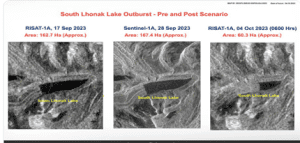
-
- Changing nature of Precipitation- The industrial releases of CO2 & other GHGs in the atmosphere have led to erratic rainfalls and changes in nature of precipitation in the Himalayan regions from snow to rain. The dry periods are increasing in the Eastern Himalayan region. Even a slightly higher rainfall than usual is likely to disturb the moraine dams and induce GLOFs.
- Cloudbursts– As per the IPCC’s Special Report on Oceans & Cryosphere, a 2 °C global warming scenario could lead to a warming of around 2.7 °C in glaciated river basins. This is highly likely to increase incidences of cloudbursts in the Hindukush-Himalayan region because of intense convection conditions created as result. The recent Sikkim Floods due to breaking of Lhonak lake is manifestation of the impact of the rising cloudbursts.
- Unsustainable development in Himalayan states & disregard to carrying capacity of the fragile ecosystem-
- Hydroelectric projects- The thrust to hydroelectric power projects in areas of high altitudes and fragile ecology has compounded the threats from potential GLOFs. Although the issue of inadequate capacity of the Teesta 3 hydroelectric reservoir was raised during the public hearings conducted under the EIA, no alternative proposals were considered, and the project was given a green light.
- Unscientific infrastructure creation- The construction and widening of roads & tunnels (such as the ongoing 45 km-long Sivok-Rangpo rail project in Sikkim), etc. in the ecologically sensitive mountain areas increase the geological stress on the already sensitive ecosystems and raise apprehensions of GLOFs. Apart from the dams, numerous pharmaceutical companies, smart city projects and congested urban planning are putting more pressure on the ecology.
- Tourist load- The uptick in tourist load in the Himalayan states of India and destruction of natural vegetation from slopes and valleys, now painted with dense buildings, lodging and recreation facilities have increased the risks from disasters like GLOFs.
IMPLICATIONS OF GLOFs
The extent of damages from glacial lake outburst floods depends on the location of such glacial lakes, their size, population inhabiting valleys and the drainage basins, among many other factors. The implications of such floods are as stated below-
LOSS OF LIFE & FORCED DISPLACEMENTS
- Depending on the severity of the disaster, the GLOFs have been noted to take a heavy toll on the life of humans and livestock.
- More than 5000 people lost their lives during the Kedarnath floods (2013).
- The loss of livelihood, damaged houses and property force displacements of the affected people.
- Besides the tangible losses, the death of family members is a huge psychological loss for those who survived.
ECONOMIC LOSSES
Connectivity- The flash floods due to bursting of glacial dams/lakes cause caving in of roads and tunnels.
Agriculture- The engulfing of horticultural fields by fast-pacing floods, mudslides and landslides due to GLOFs causes huge losses to agriculture-dependent population of the affected areas.
Industries and Tourism- The collapsing buildings, damaged infrastructure and halted industrial activities in the wake of GLOFs increase the hardships for the locals. Tourism remains depressed even months and years after the disaster has taken place.
ENERGY CRISIS
The GLOFs damage the hydroelectric power plants situated in the mountains. For instance: the floodwaters from the South Lhonak glacial lake damaged the 1,200-MW Teesta-III hydel project at Chungthang.
ENVIRONMENTAL DAMAGES
The GLOFs and consequent landslides uproot the green cover, inundate the protected areas in the pathway of overflowing rivers and leads to loss of biodiversity.
The sedimentation due to GLOFs tends to disrupt the natural flow of rivers and harms the natural river chemistry.
The population of the affected areas also suffers from water crisis, thanks to the GLOFs and contamination of drinking water.
THE WAY FORWARD:
The following measures recommended by the NDMA guide the government and other stakeholders to mitigate the risks from rising instances of GLOFs-
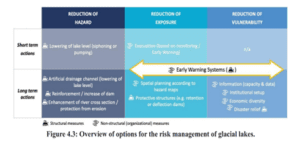
- Hazard mapping- To identify potentially dangerous lakes, one should ideally draw upon multiple sources of information, combining large-scale first order assessment results (including trans-boundary threats), with knowledge available from previous state level investigations and studies.
Global Best Practice- Switzerland
Hazard maps, according to the federal guidelines (Federal Flood Protection Law and the Federal Forest Law) express three degrees of danger, represented by corresponding colours: red, blue and yellow. This ensures homogeneous and uniform means of assessment of the different kinds of natural hazards affecting Switzerland. It guides the spatial planning and land-use policy in the country and has helped reduce casualties from such disasters.
- Field investigations of glacial lakes including topographical and bathymetric mapping, hydro-meteorological observations, and surveys is imperative. NDMA has recommended use of Synthetic-Aperture Radar imagery to automatically detect changes in water bodies, including new lake formations, during the monsoon months.
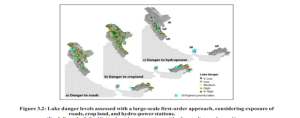
- Index-based approaches can be used by combining standardised indices for hazard, exposure, and vulnerability.
- Advanced Early Warning System (EWS) and Timely Evacuation- Since GLOFs are very fast processes, an evacuation must be executed within a very short time, this requires a robust early warning and dissemination infrastructure, clear protocols for all involved actors, and capacitation of the involved population and responsible authorities.
- Ramp up Himalayan Research- The need of the hour is to undertake more research in the Himalayas through robust implementation of initiatives such as the National Mission for Sustaining the Himalayan Ecosystem to understand the sensitivity of the region.
- Strengthen EIA framework- The scientific and sustainable planning of infrastructure in such disaster-prone regions can be ensured through reorientation of EIA framework in the country by strengthening the public hearing stage and ensuring responsiveness of authorities.
- Hazard Reduction Options- Actions aiming at a reduction of the hazard typically involve structural measures at the glacial lake itself and thus aiming at a reduction of the outburst susceptibility or a reduction of the magnitude of a potential event. These methods include:
- Lowering of the lake- Lowering the lake level by siphoning or pumping helps reduce the volume of the lake (and thus the potential flood volume and peak discharge) and increases the freeboard of the dam.
- Retention basins, and/or deflection dams are the other structural measures which can help reduce risks from GLOFs.
Success Story of Peru- Reinforcing the dam with a stone facade provides protection against erosion and the initiation of a breach formation. Such measures have been successfully applied to more than 35 lakes in the Cordillera Blanca, Peru over the past seven decades.
- Regulations on land use- Restricting constructions and development in GLOF/LLOF prone areas is a very efficient means to reduce risks at no cost. The construction of any habitation should be strictly prohibited in high-risk zones. Existing buildings are to be relocated to a safer nearby region and all the resources for the relocation have to be managed by Central/State governments.
- Vulnerability Reduction- Capacity-building of local population, civil society organisations and SDMF/NDMF along with strengthened framework for insurance & compensation are the much-needed steps.
- Set up National Centre for Glaciology: NDMA has strongly suggested the need to establish a single nodal agency to coordinate the cumulative effort to reduce such disaster in Indian Himalayan Region.
FRAGMENTED APPROACH IN INDIA TO MANAGE GLOFs in India as of now-
The survey and monitoring of glaciers are done by the Geological Survey of India (GSI), which is under the Ministry of Mines.
Scientific research is coordinated by the Department of Science and Technology; Climate change studies and impacts are the domain of the Environment Ministry; while rainfall and precipitation are monitored by the India Meteorological Department (IMD), which functions under the Earth Sciences Ministry.
The Central Water Commission works on the hydrology aspects; avalanches are monitored by an agency that is part of Defense Research and Development Organization (DRDO); while remote sensing is being done by the National Remote Sensing Agency (NRSA), which is a part of ISRO.
THE CONCLUSION- Climate change and ill-conceived development are expected to alter and potentially increase the probability for lake outbursts in the future posing potential threats in the downstream settlements. This underscores the need for a comprehensive Himalayan GLOF Mitigation Policy with a strong community-based and decentralised framework.
MAINS PRACTICE QUESTIONS
Q. Explain the mechanism and occurrence of Glacial Lake Outburst Floods (GLOFs) in the Indian Himalayan Region. Give two recent examples.
Q. Describe the various causes and implications of Glacial Lake Outburst Floods (GLOFs) in the country. Also, suggest the mitigation measures that are necessary to reduce the risks associated.
Q. The frequency of Glacial Lake Outburst Floods (GLOFs) is increasing every year in Indian subcontinent. Discuss the causes and highlight the mechanisms suggested by NDMA to mitigate risks from such disasters.
Spread the Word
